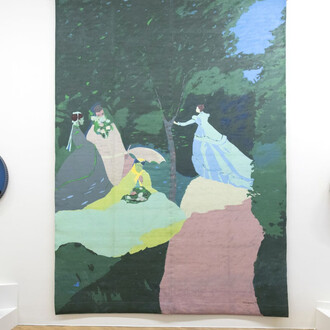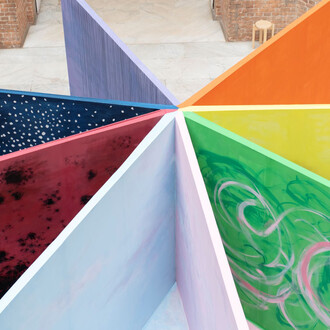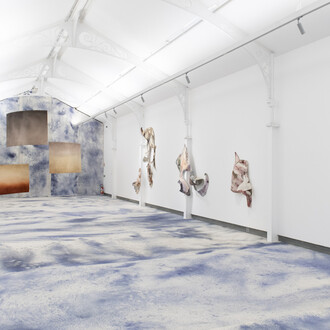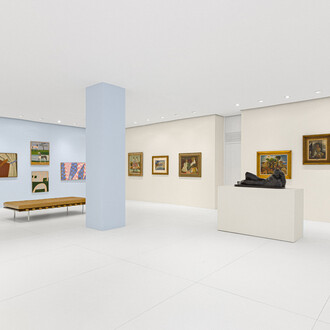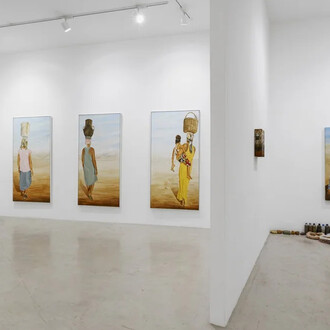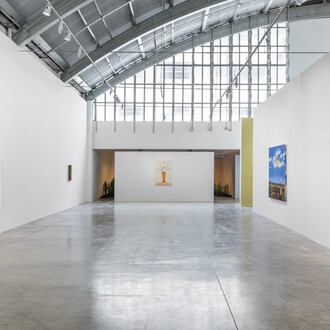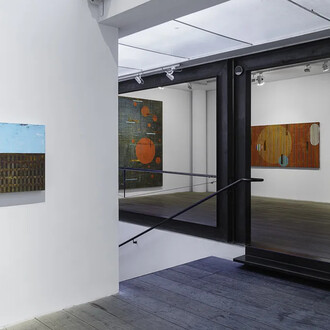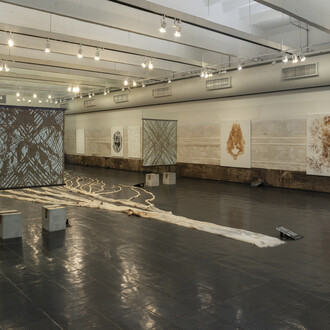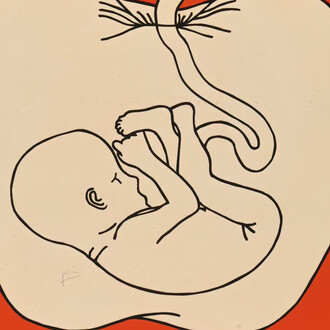An exhibition featuring the work of Valeska Soares, originally from Minas Gerais and based in New York since 1990, spans 30 years of her artistic production, and includes paintings, collages, objects, installations and sculptures.
The Pinacoteca de São Paulo, a museum of the São Paulo State Secretariat for Culture, Curated by Júlia Rebouças, the exhibition occupies the fourth floor and the entrance space of Pina Estação and presents a selection of Valeska Soares’ work from the last 30 years, in which the main presents the exhibition Valeska Soares: Entrementes [In the Meantime] from August 4 to October 22, 2018. themes center on the subject and the body, memory and affects, and the relationship between space, time and language.
Born in Belo Horizonte, in the state of Minas Gerais, in 1957 and based in New York since the early 1990s, Soares is one of an international group of artists who have expanded the possibilities of installation in art by subjectively engaging the viewer, with sculpture as her primary medium. Her works often call upon fictional narratives in literature to weave experiences of intimacy and desire that reach beyond the individual sphere and elicit a collective sensibility.
With her use of evocative materials, the artist explores the tension created by oppositions. Her sculptures and installations often feature reflective materials such as stainless steel and mirrors, in contrast with organic and sensory materials such as flowers, in order to enhance the visitor's experience. It is to this effect that Soares makes use of a variety of sensory techniques, including sound, to create atmospheres and experiences that are at once inviting and disturbing.
For the exhibition at the Pinacoteca, Júlia Rebouças has selected 40 works from the museum’s own collection and from private collections, as well as works lent by the artist herself, some of which have never been seen in Brazil. As the title of the exhibition suggests, the paintings, collages, objects, installations and sculptures displayed present intermediary contact zones: the intersections between the individual and society, between the covert or mysterious and the explicit, between the past and future, etc. "The exhibition also includes works that explores the idea of collectivity, whether through the act of collection, which Soares explores in a number of her works, or by constructing a shared experience, as in Epílogo (2016) or Vagalume (2007)". Valeska Soares: Entrementes deals, in general, with all that which concerns the intimate but can be lived in communion. “In this sense, Detour (2002) - inspired by the tale Cities and Desire by the Italian writer Ítalo Calvino - is a central work, since it originates from the idea of the same dream that is dreamed and narrated by different people," explains Rebouças. In the story, the dreamers, hoping to find the object of their desire - a woman running naked - end up creating a city that replicates the paths where they lost her. Soares uses the tale as her inspiration to create an environment that, although confined, suggests an infinite number of exits through the use of mirrorings.
The artist also incorporates architectural qualities into her practice, a result of her training as an architect. From this perspective she embraces the idea of a vanishing point as the central axis and construes the space not only as a physical and illusory entity, but as a place that allows visitors to perceive themselves in relation to it. “The artist does not separate her work from the public. The works openly present themselves, they leave clues to how they were created, which are evident in their material construction, opening up to the game of sentient engagement and participation,” says Rebouças. “Part of the strength of her poetics lies in that which evaporates, flows, fades, wilts, silences, dissolves, melts, breaks," the curator adds. The 1998 installation Untitled (From Vanishing Points), from the Pinacoteca’s collection, is an example of this. In this work the artist reproduces a set of potted plants as they were arranged in her garden. Replicated in wax, porcelain and aluminum, they mark the absence of life as an organic force, while they are signs of another time or existence that escapes the attempt to restrain it. In this way they replicate the structure of memory, since it is only possible to look back and remember from the present, and it is from the experience of the now that one fills the gaps of the past. The exhibition by Valeska Soares is part of the retrospective series of exhibitions being housed on the 4th floor of Pina Estação dedicated to artists who started their careers in the 1980s.
Soares was born in Belo Horizonte / MG in 1957 and lives and works in New York / USA. She graduated in Architecture from the Santa Úrsula University in Rio de Janeiro and has a post-graduate degree in the History of Art and Architecture from the Pontifical Catholic University (PUC), also in Rio de Janeiro. After moving to New York in 1992, she continued her studies with an MFA (Master of Fine Arts) from the Pratt Institute in Brooklyn and then began studying for a Ph.D. at New York University. Her first solo exhibition at a museum was held at the Portland Institute for Contemporary Art, USA, in 1998, and her first retrospective was seen at the Pampulha Museum of Art in Minas Gerais, Brazil in 2002. The following year the Bronx Museum for the Arts in New York held a major exhibition of her work. Soares has produced site-specific installations for various venues, including inSite in San Diego-Tijuana / USA (2000); the Tamayo Museum in Mexico City (2003) and the Inhotim Institute in Brumadinho / MG (2008). She was short-listed for the National Gallery of Canada Foundation’s Millennium Prize in 2001. She has also participated in several biennials, including São Paulo (1994, 1998 and 2009); Venice (2005); and the Sharjah Biennial, in the United Arab Emirates (2009).
Rebouças was born in Aracaju, Sergipe, Brazil in 1984, and divides her time between Belo Horizonte and São Paulo. She is a curator, researcher and art critic. She was co-curator of the 32nd São Paulo Biennial, Incerteza Viva (2016). From 2007 to 2015, she worked in the curatorial department of Instituto Inhotim / MG. She has also collaborated with Associação Cultural Videobrasil as part of the curatorial commission for the 18th and 19th International Festival of Contemporary Art SESC Videobrasil, in São Paulo. She was assistant curator of the 9th Mercosul Biennial in Porto Alegre (Se o clima for favorável) in 2013. She has curated a number of her own projects, including the exhibition MitoMotim at the VB Galpão, in São Paulo, from April to July 2018, and Zona de Instabilidade, with works by the artist Lais Myrrha, at the Caixa Cultural Sé in São Paulo Paulo, in 2013, and Caixa Cultural Brasília in 2014. She was a member of the jury responsible for selecting the architectural and curatorial project for the Brazil Pavilion at Expo Milano 2015. She is an editor and writes for exhibition catalogs, artist’s books and art journals and magazines. She graduated in Social Communication / Journalism from the Federal University of Pernambuco (2006). She holds a Master's degree and PhD in Visual Arts from the Federal University of Minas Gerais (2017).





